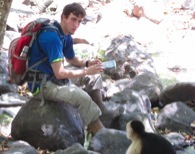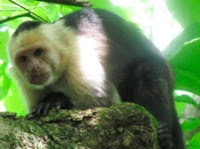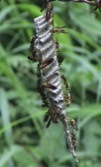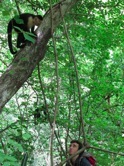Waldo’s Wasp Tale
written by Chris Hirsh, a volunteer field assistant on the project
White-Faced Capuchin Monkeys (Cebus capucinus) are widely accepted as some of the most intelligent monkeys in the entire New World. Personally there is no doubt in my mind that these monkeys are much more intelligent than we give them credit. There wasn’t a day that went by, during the year that I spent in Lomas, that I wasn’t impressed by their inventiveness and problem solving abilities. Whether it was navigating complex social hierarchies or foraging dangerous prey, the variation of solutions among individuals, to these common challenges, suggests an impressive level of cognitive reasoning. This fact was never as evident to me as it was while working with the Musketeers group during wasp breeding season.
 The beginning of the wet season (July-August) in Lomas Barbudal Biological Reserve is the breeding season for several different migratory wasp species. One of these species is Polistes instabilis or as we call them in our coding system, “PI”. These little bundles of joy are a constant source of anxiety for moneros working in Lomas because of their habit of making hidden nests, on the undersides of leaves, at exactly face height. My personal record is seven stings in one day. PI larvae are a prized delicacy for those capuchins daring enough to risk a few stings. Foraging wasp larvae involves a monkey running past a nest and snatching it before the unsuspecting wasps know what hit them. Luckily for the monkeys, PI wasps don’t pursue their attackers for more than a few feet before returning to the site where their nest used to be. At first it is almost sad to see newly homeless wasps pathetically hovering around the branch where their nest and offspring once resided. This empathy quickly fades as your sting count rises, and most moneros cheer the monkeys on as they clear the forest of these pesky wasps.
The beginning of the wet season (July-August) in Lomas Barbudal Biological Reserve is the breeding season for several different migratory wasp species. One of these species is Polistes instabilis or as we call them in our coding system, “PI”. These little bundles of joy are a constant source of anxiety for moneros working in Lomas because of their habit of making hidden nests, on the undersides of leaves, at exactly face height. My personal record is seven stings in one day. PI larvae are a prized delicacy for those capuchins daring enough to risk a few stings. Foraging wasp larvae involves a monkey running past a nest and snatching it before the unsuspecting wasps know what hit them. Luckily for the monkeys, PI wasps don’t pursue their attackers for more than a few feet before returning to the site where their nest used to be. At first it is almost sad to see newly homeless wasps pathetically hovering around the branch where their nest and offspring once resided. This empathy quickly fades as your sting count rises, and most moneros cheer the monkeys on as they clear the forest of these pesky wasps. its unsuspecting prey. The monkey will then run at full speed and reach out with its highly skilled hand to snatch either the wasp nest itself or snap off the limb that the nest is hanging from. The conventional technique exposes a monkey’s face and hands to the possibility of painful stings. Although it never happened in the year I was in the field, other moneros told tales of extremely unlucky monkeys receiving a vision-impairing sting to the eye. The danger of PI stings is made all the more apparent when you observe the fearful and threatening reactions of onlooker monkeys, as an exceptionally large nest is foraged. The hand foraging technique can be seen in all of the Lomas study groups; however in the Musketeers study group, a few individuals have invented a new foraging technique.
its unsuspecting prey. The monkey will then run at full speed and reach out with its highly skilled hand to snatch either the wasp nest itself or snap off the limb that the nest is hanging from. The conventional technique exposes a monkey’s face and hands to the possibility of painful stings. Although it never happened in the year I was in the field, other moneros told tales of extremely unlucky monkeys receiving a vision-impairing sting to the eye. The danger of PI stings is made all the more apparent when you observe the fearful and threatening reactions of onlooker monkeys, as an exceptionally large nest is foraged. The hand foraging technique can be seen in all of the Lomas study groups; however in the Musketeers study group, a few individuals have invented a new foraging technique.I don’t know which monkey originated the unique tail foraging behavior in the Musketeers group, but it would be absolutely fascinating to see if and how it spreads to other monkeys. Will the other monkeys be able to recognize the superiority of this novel behavior and adopt it, or will they stick with their tried and true method of hand foraging? Which method will the juveniles try as they learn how to forage on the dangerous prey? If Waldo migrates again, will other groups learn and adopt this technique from him? Tail foraging versus hand foraging is one of many behaviors that can be studied to gain insights into how novel behaviors arise and spread in non-human primate species, and provides great fodder for the non-human culture debate. It is also only one of the many fascinating and inspiring observations I made while working with the incredible capuchin monkeys of the Lomas Barbudal Monkey Project’s study population.




